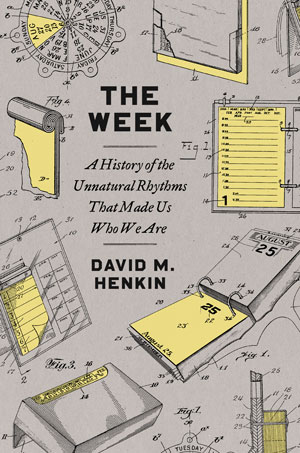
This is a book about how we experience and imagine time. Although treatments of that subject often focus on the clock, modern time consciousness is organized around calendars as well. The Week considers one of the most powerful calendrical rhythms in our lives. Seven-day cycles are ancient timekeeping devices, but they are completely conventional and until the last century many parts of the world functioned smoothly without them. Only in the modern era have seven-day rhythms become the dominant beat in our lives, so much so that not knowing the day of the week presents as a singular symptom and symbol of disorientation.
Other inquiries into weekly timekeeping have observed its artificial character, but this book explores the modern week as the product of historical changes. How did we come to be so attached to our weeks? Part of the answer has to do with industrial labor arrangements, which use the traditional seven-day Sabbath cycle to regulate the relationship between work and leisure. The modern week, however, is not simply an alternation between weekdays and weekends. If it were, then we would probably be less viscerally attached to the different feel of Tuesdays and Wednesdays, for example. Those days have distinctive characters, not simply because of their relative positions in the work cycle (or the cycle of Sabbath observance), but because so many of us have different routines and schedules on different days of the week.
My account of the week in the United States argues that a crucial historical development entrenched weekly calendars in the mental time-maps of ordinary Americans. Starting in the early nineteenth century, masses of people in the United States, especially those living in towns and cities, attending school, earning wages, performing housework, going to the theater, joining lodges, reading newspapers, receiving mail, or doing numerous other things that relied on the technology of the week to coordinate the activities of strangers, suddenly had new reasons for caring where they stood in the seven-day cycle.
My book documents this historical development for those readers who might be curious (or skeptical) about how and when it happened, but it also traces how the new weekly consciousness shaped the way Americans remembered and accounted for events in their lives – in their diaries, memoirs, and personal correspondence, and even when called into court to testify. Because weeks became so linked to memory, their rhythms acquired a firmer grip on mass time consciousness. This in turn helps explain both why attempts to modify the weekly calendar have failed, and why in times (such as the recent pandemic shutdown) when we lose track of our weeks, the blurring of our Tuesdays and Wednesdays can make us feel more generally unmoored.
Historians traffic in timekeeping, and time is the fundamental building block of historical scholarship, whether we are telling stories about change, persistence, sequence, or simultaneity. So in a way, books like this, which study how earlier societies experienced the time units that historians depend upon to make sense of the past, are contributions to the basic science of our discipline.
In my own scholarship on nineteenth-century America, however, a study of the week fits a more particular pattern. I have always been drawn to the history of unspectacular technologies that have contributed in subtle ways to the modern experience of connectedness. Rather than looking at the impact of steam railroads, combustion engines, electromagnetic telegraphy, faster printing presses, innovative techniques of photography and film, or other celebrated inventions, I have made a career of studying much older methods of communication and social organization (written signs, printed newspapers, postal relays) that have been used in novel ways, typically without fanfare, to create broad, impersonal networks of connection among masses of people. These networks are typically forms of invisible social infrastructure, whose users occasionally commented upon their power or novelty but which we mostly now take for granted.
I became curious about the history of the week for similar reasons. More than just a religious observance or calendar of rest days, the modern seven-day week is a form of social infrastructure. It incorporates the habits, routines, and rhythms of people we don’t see and might not even know, and it weaves those habits, routines, and rhythms into the fabric of time as we perceive it.
I wrote the book’s preface in the expectation that it would draw a potential reader into a deceptively familiar subject. The global shutdown in 2020 exposed all sorts of odd and interesting things about our relationship to schedules and calendars, turning us all into philosophers and sociologists of time. So I tried to mobilize that consciousness as a way of inviting people into thinking of the week as a powerful but perhaps fragile human construct and leading them on a tour of its history in the United States over the past couple of centuries. A reader who begins with the preface is likely to understand (and ideally share) the curiosity that drives this inquiry.
Other kinds of readers might be drawn to other sections. Readers who have never considered why we still count continuous cycles of seven days, despite its inconvenience, might be most intrigued if they opened to the pages in Part Four (around pp. 170-178) where I recount some of the reform efforts that failed to dislodge the week from its awkward perch atop the other calendar units.
Readers who are surprised by the claim that the modern week was the product of things other than labor and religion, might be drawn to Part II, where I survey the varied and unsuspected places where weekly habits took hold in the early 1800s.
I would hope that another kind of reader would alight upon the pictures of almanacs and pre-formatted diaries (around pp. 124-30) and reflect upon how our mental maps of time connect to their visual representation.
But kindred spirits might recognize most clearly what I’m up to if their first brush with book focuses on Part III, titled “Does Anybody Really Know What Time It Is?” More than anything else, the question of whether people know their place in the weekly calendar – and why they care – holds the key, I think, to the mystery and the power of seven-day timekeeping.
I think a study of the week can convey two important lessons about the history of timekeeping. First, that time units that are culturally relative and rooted in human artifice can be as powerful as those that are universal and appear dictated by astronomy or biology. And second, that the role of human artifice in the history of timekeeping is not just about mechanical devices or technological innovations. Rather it is a story of conventions, laws, economic relations, cosmological beliefs, unconscious habits, and quiet social agreements.


David Henkin has taught U.S. history at the University of California, Berkeley, since 1997. His classes at Berkeley over the years have focused especially on theater and sports, slavery and labor, media and communication, and family and sexuality. He is the author of three previous books – City Reading, The Postal Age, and (with Rebecca McLennan) Becoming America – as well as numerous short articles. His current book projects explore baseball and partisan politics. Born in Paris and raised in New York City, he makes his home in San Francisco and in Montana.